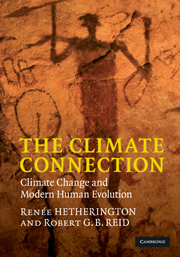Book contents
- Frontmatter
- Contents
- Foreword
- Preface
- Acknowledgements
- 1 Introduction
- Part I Early human history
- 2 From ape to human: the emergence of hominins
- 3 Human behavioural evolution
- 4 The migrations and diaspora of Homo
- Part II Climate during the last glacial cycle
- Part III The interaction between climate and humans
- Appendices: The biological background to the story of evolution
- References
- Index
- Plate section
3 - Human behavioural evolution
Published online by Cambridge University Press: 05 August 2012
- Frontmatter
- Contents
- Foreword
- Preface
- Acknowledgements
- 1 Introduction
- Part I Early human history
- 2 From ape to human: the emergence of hominins
- 3 Human behavioural evolution
- 4 The migrations and diaspora of Homo
- Part II Climate during the last glacial cycle
- Part III The interaction between climate and humans
- Appendices: The biological background to the story of evolution
- References
- Index
- Plate section
Summary
Even though the three living great apes are more closely related to us than to any other living primates, and one or two of these great apes are probably our closest living relatives, the actual, closest relatives of H. sapiens, and of each great ape, as well, are now extinct. In contrast … the closest relatives of most living species are also living.
(Schwartz, 1999, pp. 18–19)H. sapiens embodies something that is undeniably unusual and is neatly captured by the fact that we are alone in the world today. Whatever that something is, it is related to how we interact with the external world: it is behavioral.
(Tattersall, 2003, p. 24)Introduction
The human species has a number of uncommon features, one being that we are the only surviving species of our genus Homo. We did have close human relatives such as H. erectus and H. neanderthalensis at one time, and we probably coexisted with both of them before they became extinct. As Ian Tattersall infers, explanations of such an unusual condition might be found through a study of human behaviour and its evolution. As a general principle, behaviour has been a primary factor in all of animal evolution, since it presented organisms with novel conditions of life that influenced their development and physiology. Once mammals acquired the adaptable physiological homeostasis typical of marsupials and placentals, exploratory behaviour exposed them to extreme environments that demanded new behavioural responses, and those ultimately included the ability to change the environment.
- Type
- Chapter
- Information
- The Climate ConnectionClimate Change and Modern Human Evolution, pp. 39 - 78Publisher: Cambridge University PressPrint publication year: 2010



